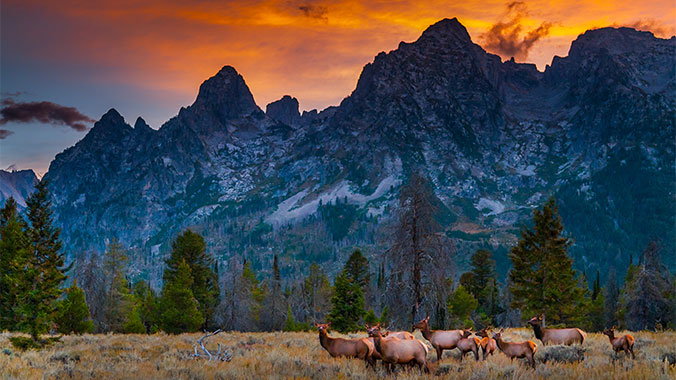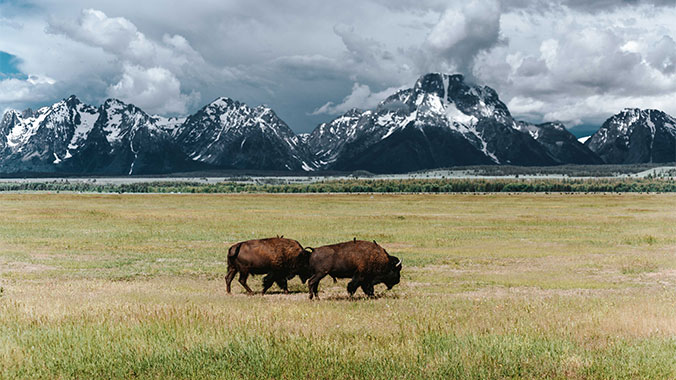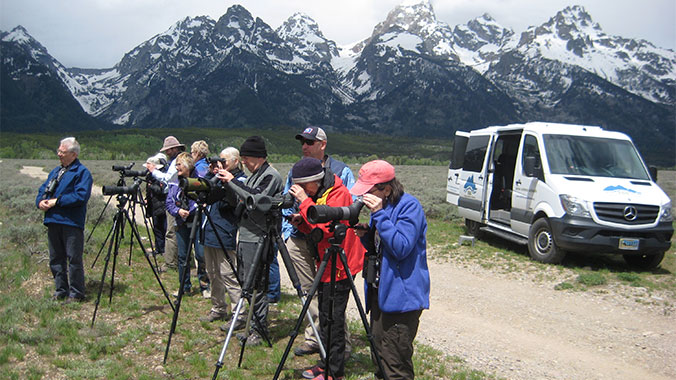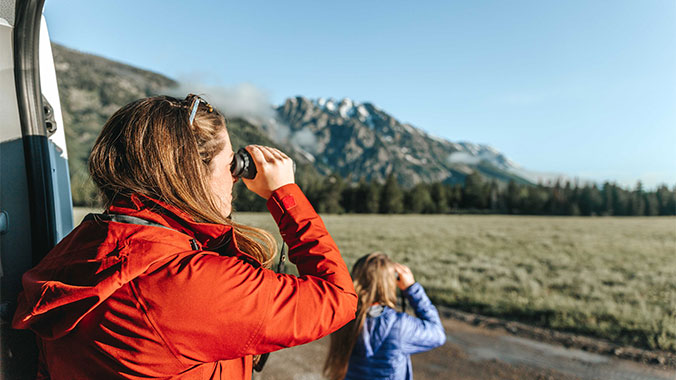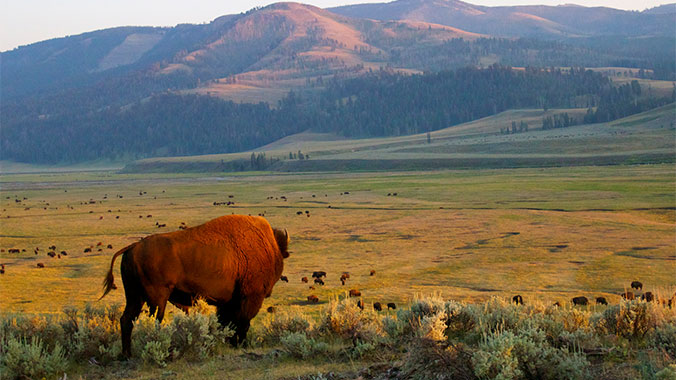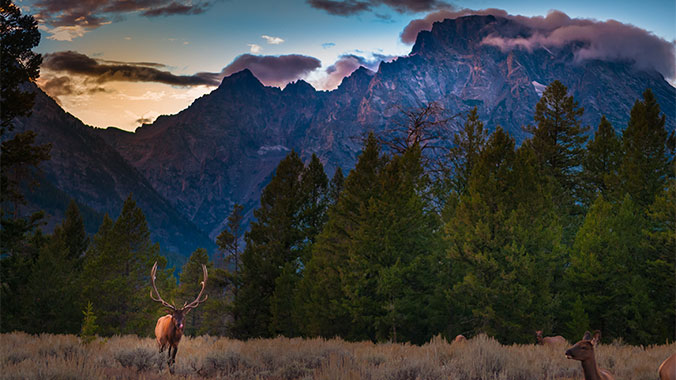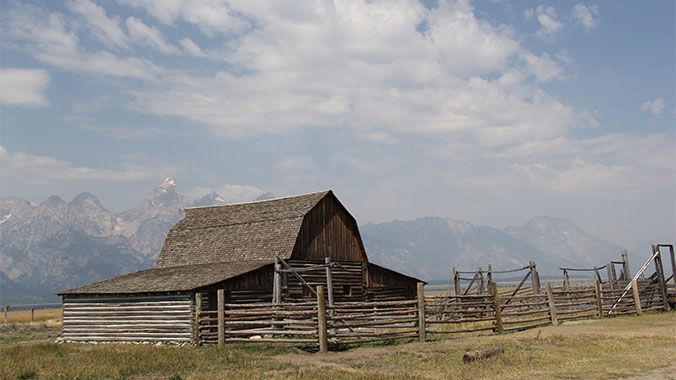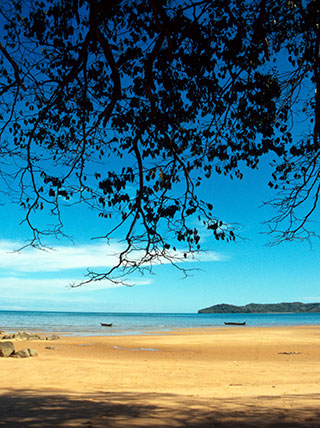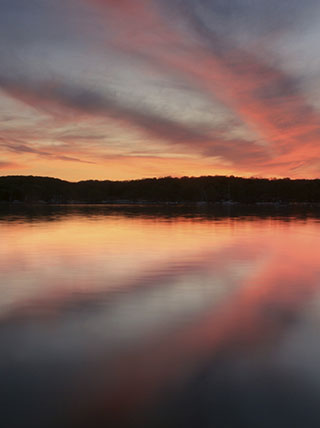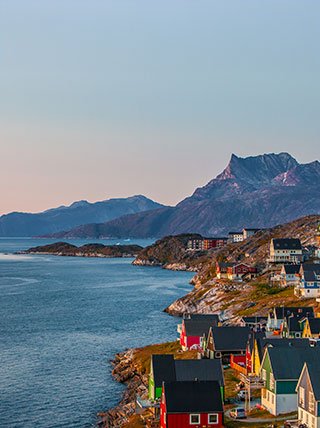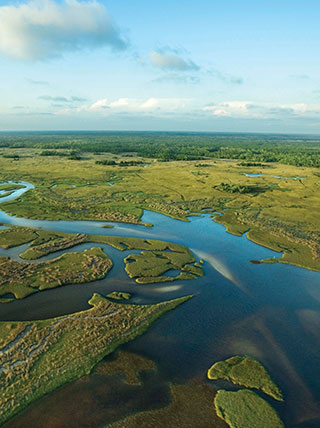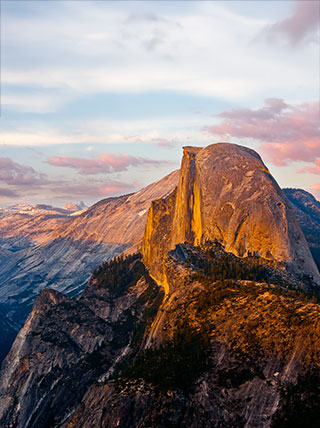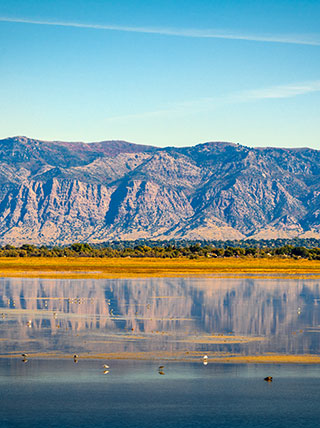Wyoming/Montana
Wildlife Watching in Grand Teton and Yellowstone National Parks
Program No. 23111RJ
Learn about the diverse animals in Grand Teton and Yellowstone National Parks as expert biologists take you to little-known spots for the best wildlife searching.
Enroll with Confidence
We want your Road Scholar learning adventure to be something to look forward to—not worry about. Learn more
Protecting the Environment
We offset a portion of the emissions created by your travel. Learn more
Itinerary
While we make every effort to ensure the accuracy of our published materials, programs are typically advertised more than a year prior to their start date.
Read More.
While we make every effort to ensure the accuracy of our published materials, programs are typically advertised more than a year prior to their start date. As a result, some program activities, schedules, accommodations, personnel, and other logistics occasionally change due to local conditions or circumstances. Should a major change occur, we will make every effort to alert you. For less significant changes, we will update you during orientation. Thank you for your understanding.
Duration
7 days
6 nights
What's Included
14 meals (
6B, 4L, 4D
)
2 expert-led lectures
11 expert-led field trips
An experienced Group Leader
6 nights of accommodations
Taxes and customary gratuity
Road Scholar Assurance Plan
Day
1
Check-in, Registration, Orientation, Welcome Dinner
Location:
Jackson, WY
Meals:
D
Stay:
The Rockwell Inn
Activity Note
Hotel check-in from 4:00 p.m.
Afternoon:
Program Registration. After you check in at the hotel and get your room assignment, head to your room where you will find any updated information and confirm the time and location of the Orientation session. If you arrive late, please locate your Group Leader and let them know you have arrived. We will gather in the hotel lobby with our Group Leader and fellow Road Scholars at 6:15 p.m. and ride to dinner followed by Orientation.
Dinner:
At a local restaurant.
Evening:
Orientation: The Group Leader will greet everyone and lead introductions. We will review the up-to-date program schedule, discuss roles and responsibilities, logistics, safety guidelines, emergency procedures, and answer questions. Program activities will be led by a combination of Wildlife Expeditions biologists, local experts, and experienced docents. Hikes will be on official trails in Grand Teton and Yellowstone National Parks or the surrounding national forest land. Expect uneven terrain with elevation changes of up to 600 feet. The entire program is at high elevations, typically at 6,000 to 8,000 feet above sea level. Travel and transfers will be via Wildlife Expeditions vehicles: closed, safari-style vehicles designed for wildlife viewing. Periods in the daily schedule designated as “Free time” and “At leisure” offer opportunities to do what you like and make your experience even more meaningful and memorable according to your personal preferences. The Group Leader will be happy to offer suggestions. Program activities, schedules, personnel, and indicated distances or times may change due to local circumstances/conditions. In the event of changes, we will alert you as quickly as possible. Thank you for your understanding.
Day
2
Grand Teton Wildlife Safari, National Museum of Wildlife Art
Location:
Jackson, WY
Meals:
B,L
Stay:
The Rockwell Inn
Activity Note
Early start. Sitting in vans. Getting on/off vans with high step. Walking up to 1/2 mile; trails with uneven surfaces.
Breakfast:
At the hotel.
Morning:
We start early almost every day because that is when wildlife is out. This morning, we’ll set out on wildlife safari through Grand Teton National Park to look for moose, elk, birds of prey, and other wildlife with a Wildlife Expeditions biologist who will provide expert commentary. As we ride, we’ll take in the majestic views of the iconic Teton mountain range.
Lunch:
In Grand Teton National Park, we’ll have boxed lunches.
Afternoon:
For our next field trip, we will ride to the historic Murie Ranch in Grand Teton National Park, former home of Olaus and Mardy Murie, and the birthplace of the modern wilderness movement. Olaus Murie was a renowned naturalist who studied elk and other wildlife in Jackson in the early to mid-1900s. He went on to become President of The Wilderness Society. His wife, Mardy, carried on his conservation ethic after he passed away, and became known as “the grandmother of the conservation movement”. We’ll feel their story come alive as we explore the log cabin ranch where they lived and worked. Next, we’ll ride to the National Museum of Wildlife Art for a self-directed exploration to examine the connection between wildlife, art, and conservation. Resting upon a dramatic cliff overlooking the National Elk Refuge, the National Museum of Wildlife Art serves to enrich and inspire the relationship between humans and nature. The museum contains more than 5,000 works of art, with exhibitions and programs that focus on wildlife of the world. We’ll return to the hotel after our field trips.
Dinner:
This meal has been excluded from the program cost and is on your own to have what you like in Jackson. The Group Leader will be happy to offer suggestions. There are numerous eateries to choose from.
Evening:
At leisure. Prepare for check-out and transfer in the morning.
Day
3
Yellowstone National Park, Old Faithful Geyser Basin
Location:
West Yellowstone
Meals:
B,L,D
Stay:
Yellowstone Lodge
Activity Note
Early start. Sitting in vans. Getting on/off vans with high step. Walking up to 1 mile; boardwalks in geyser basins.
Breakfast:
At the hotel.
Morning:
We will check out of the hotel, board our safari vehicles, and set out on our four-day exploration of Yellowstone, America’s first national park. We will stop to see and learn about several points of interest as we head to the Old Faithful Geyser Basin, home to Old Faithful as well as nearly one-quarter of all of the geysers in the world.
Lunch:
In Yellowstone National Park, we’ll have boxed lunches.
Afternoon:
Next, we’ll explore the Old Faithful Geyser Basin, walking on the boardwalks in the area. The Upper Geyser Basin is home to more than half of the world’s geysers. We’ll learn about the different types of thermal features and why so many of them are in this part of Yellowstone. Then, we’ll ride to our hotel in West Yellowstone, stopping to view wildlife and at other points of interest along the way. After checking into our hotel, we’ll gather with our Group Leader for a presentation on wolves that reside in the Greater Yellowstone ecosystem. We’ll learn about the reintroduction of wolves to Yellowstone, wolf behavior and biology, and gray wolf interactions between packs. We’ll also discuss the controversies surrounding wolves and how current decisions will affect the animals’ futures.
Dinner:
At a local restaurant.
Evening:
At leisure. Prepare for check-out and transfer in the morning.
Day
4
Mammoth Hot Springs, Lamar Valley, Dan Hartman Gallery
Location:
Cooke City, Montana
Meals:
B
Stay:
Super 8
Activity Note
Early start. Sitting in vans. Getting on/off vans with high step. Walking up to 1 mile; boardwalks, trails.
Breakfast:
At the hotel.
Morning:
We will ride to the northwest corner of Yellowstone to explore Mammoth Hot Springs. We’ll walk through the Mammoth terraces on the boardwalk as we learn about these unique geologic features.
Lunch:
On your own to have what you like at Mammoth Hot Springs. The Group Leader will be happy to offer suggestions.
Afternoon:
Our next field trip will take us through the scenic Lamar Valley, called the Serengeti of North America for its abundance of wildlife. We’ll stop to view bison herds, pronghorn, and other wildlife as we make our way to our hotel in Cooke City. Using our binoculars and spotting scopes, we'll get a closer look at the young of the year, who will stick close to their parents. We’ll drive to Cooke City and check in to our hotel after the field trip.
Dinner:
On your own to have what you like.
Evening:
At leisure.
Day
5
Wildlife Watching in Lamar Valley
Location:
Cooke City, Montana
Meals:
B,L,D
Stay:
Super 8
Activity Note
Early morning field trip to view wildlife at dawn. Sitting in vans. Getting on/off vans with high step. Hiking up to 2 miles; uneven surfaces.
Breakfast:
At the hotel.
Morning:
We’ll set out early in search of wolves, bears, and other wildlife in the Lamar Valley with our Group Leader, a trained biologist. We’ll learn the stories of specific wolf packs in the area, and observe firsthand how the reintroduction of wolves has shaped the landscape of our nation’s first national park as we use spotting scopes to view wildlife.
Lunch:
At a scenic spot, we’ll have boxed lunches.
Afternoon:
We’ll stretch our legs on a hike in the Lamar Valley, where we will explore wolf habitat and learn about the rocks, plants, and animals that make this valley unique. Next, we’ll meet Dan Hartman at his home in Cooke City to view his wildlife photography as he tells stories behind the photos.
Dinner:
At a local restaurant.
Evening:
At leisure. Prepare for check-out and transfer in the morning.
Day
6
Grand Canyon of the Yellowstone River, Hayden Valley
Location:
Jackson, WY
Meals:
B,L,D
Stay:
The Rockwell Inn
Activity Note
Early start. Sitting in vans. Getting on/off vans with high step. Walk about 1/2 mile along the Grand Canyon of the Yellowstone; paved surfaces, boardwalks.
Breakfast:
At the hotel.
Morning:
We’ll ride through the Lamar Valley one more time looking for wildlife, then make our way to the Grand Canyon of the Yellowstone River. From the National Park Service: “The Grand Canyon of the Yellowstone River expresses the park's complex geologic history in dramatic colors and shapes. Puffs of steam mark hydrothermal features in the canyon's walls. The Upper and Lower Falls of the Yellowstone River add to the grandeur of the unique natural treasure.” We’ll walk about 1/2 mile along the canyon rim to view the waterfalls and learn about the area’s geology.
Lunch:
At a scenic spot, we’ll have boxed lunches.
Afternoon:
We will ride to the Canyon Visitor Center for a self-directed look at the geology and geologic forces that are active in Yellowstone. On our return to Jackson, we’ll ride through the Hayden Valley, keeping our eyes on the landscape as we look for large mammals that call this valley home. We may see bison, bears, elk, and all kinds of birds.
Dinner:
At the hotel. Share favorite experiences with new Road Scholar friends during our farewell dinner.
Evening:
At leisure. Prepare for check-out and departure in the morning.
Day
7
Program Concludes
Location:
Jackson, WY
Meals:
B
Activity Note
Hotel check-out 11:00 a.m.
Breakfast:
At the hotel. This concludes our program.
Morning:
If you are returning home, safe travels. If you are staying on independently, have a wonderful time. If you are transferring to another Road Scholar program, detailed instructions are included in your Information Packet for that program. We hope you enjoy Road Scholar learning adventures and look forward to having you on rewarding programs in the future. Don’t forget to join our Facebook page and follow us on Instagram. Best wishes for all your journeys!
Please select a day to update the map
Map details are not available for this location.

